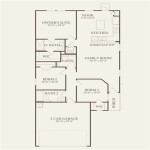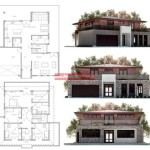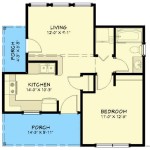House Plan Elevations: Essential Aspects for Architectural Success
The elevation of a house plan provides a graphical representation of the building's exterior walls, roof lines, and various heights. It is a vital component of architectural design, as it visually communicates the overall appearance and dimensions of the structure. Accurately drafted elevations ensure not only aesthetic appeal but also structural integrity and functionality.
Creating precise and informative elevations requires attention to several key aspects:
1. Floor Plan Coordination:
Elevations directly relate to the floor plan. To maintain accuracy, the dimensions and heights indicated on the elevations must correspond precisely with the floor plan. Careful coordination ensures a cohesive design that avoids inconsistencies between the two representations.
2. Vertical and Horizontal Lines:
Elevations are essentially orthographic projections, depicting the building's vertical and horizontal elements as straight lines. Maintaining consistency and accuracy in these lines is crucial for visually representing the structure's geometry and overall form.
3. Dimensioning and Scaling:
Elevations provide precise measurements and heights of the building's exterior. Accurate dimensioning and scaling are essential for determining the actual sizes and proportions of the various elements, such as windows, doors, and roof lines.
4. Materials and Finishes:
Elevations can indicate the materials and finishes that will be used on the exterior of the building. This information can include brick, siding, stone, or stucco, as well as any decorative elements or fixtures.
5. Roof Lines and Pitch:
The elevation accurately conveys the roof's shape, pitch, and materials. It shows the angles of the roof planes and the types of roofing materials used, influencing the building's overall aesthetic and structural performance.
6. Topography and Site Conditions:
Elevations may incorporate information about the building's relationship to the surrounding topography and site conditions. This includes indicating any slopes, retaining walls, or other features that affect the building's design.
7. Architectural Detailing:
Detailed elevations can include intricate architectural elements such as cornices, moldings, pediments, and pilasters. These details add visual interest and depth to the design, contributing to the overall aesthetic appeal and architectural character of the building.
Conclusion:
House plan elevations serve as blueprints for architects and builders, providing essential information for constructing visually stunning and structurally sound homes. They are a valuable tool for communicating design ideas, ensuring accuracy, and creating buildings that meet the needs and aspirations of their occupants.

Architecture House Plan And Elevation Complete Drawing Cadbullb Bungalow Floor Plans

Floor Plan Elevation Sample House Plans Building

Scheme Of The Tested Single Family House A Front Elevation B Scientific Diagram

What Are Elevations Building Design House

3 Bedrm 1831 Sq Ft Craftsman House Plan 109 1013

How To Read House Plans Elevations
Colonial Ranch House Plan 3 Bdrm 2097 Sq Ft The Collection

Floor Plan And Elevations For The New House Wildfire Interiors

House Plan Elevation Section Building Design Architectural Plans Small Architecture

I Ll Draw 2d Floor Plan Section Elevation In Autocad And Revit For 30 Freelancer Ekundayo Rilwan Realoneconsult Kwork








